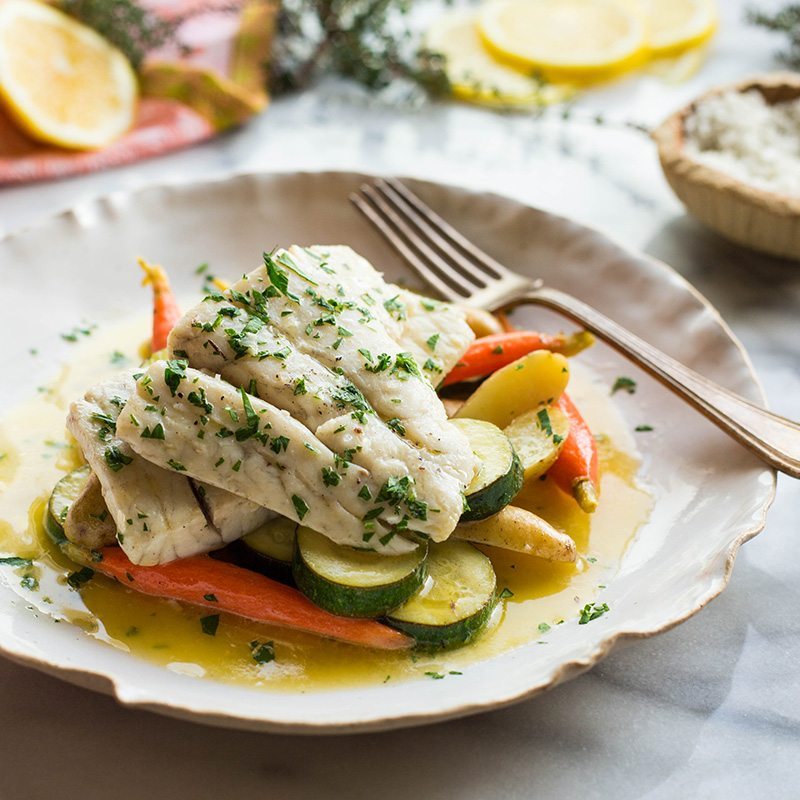Master the Art of Fish Cooking with 8 Simple Techniques

Cooking Fish Using 8 Simple Preparation Techniques
Sustainable seafood is not only nutritious (an excellent source of lean protein) it’s also incredibly versatile, meaning the ways to cook it and the potential flavors are endless.
Broiled, poached, grilled, cured, raw—are just a few of the many ways you can enjoy fish. First of all, when cooking fish it helps to know what types of fish are better for certain preparations. For example, fatty, meaty fish like salmon are good for roasting and pan-searing. Whereas white-fleshed, flaky, lean fish like sea bass is good for high heat applications like grilling and broiling. To start, here are eight simple preparation techniques that will set you well on your way to being a master fish cook.
1. En Papillote (French for “in a paper”): This technique is for fillets only (no whole fish here). Enclose each fillet in a parchment sack and roast in the oven, steaming them gently.
Use Fish That Are: Skinless, flaky and firm-fleshed fish works best. Avoid whole or oily fish.
Recipe Idea: Fish and Vegetables en Papillote
2. Grilling: Requires high and quick heat and is best for a whole fish with skin. Stuff the cavity of the fish with aromatics like citrus, allium, and herbs to enhance the flavor. Brush the fish with oil so it doesn’t stick to the grate, in addition to topping with fresh herbs for an extra aromatic additive.
Use Fish That Are: White-fleshed, fatty, skin-on fillets, or whole.
Recipe Idea: Grilled Barramundi with Asian Salsa Verde and Citrus & Fennel Salad
3. Pan Searing: Ideal for a fillet, skin on or off. If the skin is on, score it with a few diagonal slits (to prevent the fillet from curling during cooking) and cook with the skin side down in a pan.
Use Fish That Are: Flaky, firm, fatty. (If using lean fish, keep the skin on.)
Recipe Idea: Crispy Barramundi with Cauliflower, Tahini, and Pomegranate
4. Poaching: Submerge fish fillets completely in simmering water or stock; the submersion allows for the fish to be cooked evenly on all sides. Poached fish is often served cold with hollandaise sauce and new potatoes.
Use Fish That Are: Lean, flaky. Use very fresh fish, avoid overly oily fish.
Recipe Idea: Brown Butter-Poached Barramundi with Celeriac Purée & Caper Crumbs
5. Roasting: Bake in an oven at 400 F for thick fillets, and 375 F for whole fish. In addition, adding aromatics such as fresh rosemary and thyme sprigs will greatly diversify the flavor. For more delicate fish, try slow roasting at 275 F (double the cooking time).
Use Fish That Are: Fatty, large fillets or whole
Recipe Idea: Roasted Barramundi with Meyer Lemon Vinaigrette
6. Broiling: A handy option to get that grilled taste without using a grill. This technique is perfect for fillets (of any size) and small, whole fish like porgy or striped bass. Cook thawed or frozen fillets in a 400 F oven (375 F for whole fish).
Use Fish That Are: Fatty, thick fillets
Recipe Idea: Broiled Barramundi Fillets with Puttanesca Sauce
7. Raw: When eating your fish raw make sure it’s very fresh and eat it immediately. (Fish that has been properly frozen and thawed slowly is considered very fresh.) Slice the fish thinly and serve with rice or a refreshing dipping sauce.
Use Fish That Are: Quality is more important than type or characteristics. As a result, fattier fish like tuna belly is more pungent in flavor.
Recipe Idea: Barramundi Carpaccio with Blood Orange
8. Cured: Essentially, the fish is “cooked” without heat. Treat raw fish with acid, like the lime juice, for ceviche, or with salt and spices, like a gravlax, for an easy way to eat fish without much preparation.
Use Fish That Are: Similarly to when eating raw fish, quality is more important than type.
Recipe Idea: Barramundi Crudo with Mango, Kiwi, and Jicama
For more inspiration on how to put the techniques above to use, check out our sustainable seafood recipes.
Read more in our Essential Guide to Sustainable Seafood series: